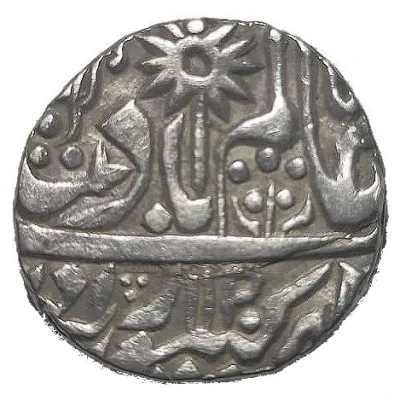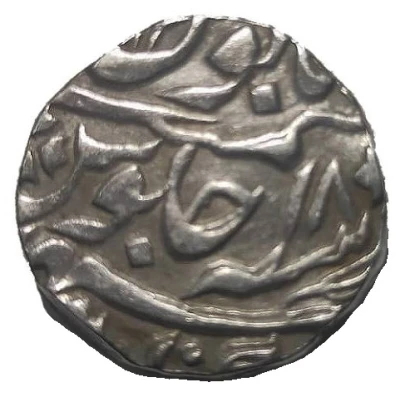


© Tanumoy Biswas
1 Rupee - Shah Alam II Hindupat Singh ND
| Silver | 11.05 g | 20.4 mm |
| Issuer | Princely state of Panna (Indian princely states) |
|---|---|
| Type | Standard circulation coin |
| Years | 1762-1785 |
| Value | 1 Rupee |
| Currency | Rupee |
| Composition | Silver |
| Weight | 11.05 g |
| Diameter | 20.4 mm |
| Thickness | 3.7 mm |
| Shape | Round |
| Demonetized | Yes |
| Updated | 2024-10-05 |
| Numista | N#253830 |
|---|---|
| Rarity index | 92% |
Reverse
From RY 18, the date moves to the middle of the bottom line of the legend. Coins with RY 18 are dated AH 1190. This is towards the end of the reign of Hindupat Singh (1758–1777), and the reason for this date being chosen for such a change is obscure. (Barry Tabor)
Lettering:
Regnal year ١٨ (18)
Mint name “shahr Chhatarpur” at bottom
Edge
Plain
Comment
Panna was a state in Bundelkhand, part of modern Madhya Pradesh, in north central India. The rulers were Bundela Rajputs of the House of Orchha. Champat Rai, sworn enemy of the Mughals, declared his independence from Delhi during the period of chaos in the Bundelkhand area that followed Jhujhar Singh of Orchha’s ill-starred rebellion in 1635 AD. During the 1650’s, Chhatarsal, Champat Rai’s son, continued to gain in power, taking and holding territory east of the Dharsan River. He extended his territory into eastern Malwa, and by 1671 AD he was master of most of Bundelkhand. His state included Banda in the north, Rewah in the east and Jabalpur in the south, and extended as far as the river Betwa in the west. He never held Datia or Orchha. His first capital was Kalinjar but Panna became the chief town in 1675 AD. Chhatarpur (founded by Chhatarsal in 1707 AD) and Jaitpur were the only other towns of any importance in the territory.[...]
When Chhatarsal died in 1732 AD, he left numerous progeny (over 50 sons are known) holding bits of territory in the area, including Panna, Charkhari, Ajaigarh, Bijawar, Sarila, Jaso, Jigin and Lugasi. The state of Panna, therefore, came into separate independent existence in 1732 AD, under Hirde Singh, who made Panna town his capital. He was succeeded by Sabha Singh (1739-1752 AD) and Aman Singh (1752-1758 AD). Aman Singh was murdered by his brother Hindupat (1758-1777 AD), who ruled Panna for nearly 20 years, before he passed it on to his son Anirudh (1777-1779 AD). Anirudh was a minor, and had regents to administer the state on his behalf, but the regents fought among themselves and, in the resulting civil war (also referred to as the ‘interregnum’), much of the territory was lost. Beni Hazuri took Maihar, Khemraj took Paldeo and Sone Sah Ponwar took Chhatarpur, leaving only the rump of the original Panna state for Dhokal Singh, brother of Anirudh, to govern independently.
[...]
There is a well-known, readily available series of rupees (Krause includes a selection as KM# 15, 17, 19, 20 and 21 of Chhatarpur “Princely” State) that carry the mint-name Chhatarpur. Received wisdom is that the Chhatarpur mint opened in 1816 AD, long after Chhatarpur State gained its independence, and so these coins have been attributed to Chhatarpur state after that date. This necessitates the assumption that all dates and regnal years on these coins, up to regnal year 27 of Shah Alam II, are fictitious, because these dates predate the separation of Chhatarpur as an independent state. This assumption was valid when only a few random, mostly undated examples were known and published, but we now know that these rupees constitute a long, unbroken series bearing regnal years and Hijra dates from year 3 of Shah Alam II (1762 AD), or earlier, until year 27 (1784/85 AD). We also have coins with the same mint name, but dated after RY 27, some of which are clearly the true coinage of Chhatarpur State. If we read the years on coins with regnal years up to RY 27 as the actual dates they were struck, and as fixed years between date changes, we will place these coins in the period before Chhatarpur state was founded as a separate entity by Sone Sah Ponwar in 1784/85 AD. At that time, Chhatarpur was an important town in Panna State. I believe this to be the only viable option, and that these familiar coins are thus demonstrated to be coins of Panna State, and not Chhatarpur State.
[...]
Coins with regnal years higher than 27 (and probably some RY 27 coins) were struck after the independence of Chhatarpur from Panna, and are coins of Chhatarpur State. Similar coins may have been struck in other states that split away from Panna after the civil war period, or might be copies of Chhatarpur mint rupees made by neighbouring polities, or both.
[...]
To identify and understand the "symbols" on these coins, check the images below:
Source: Some aspects of the History and Coinage of the Panna Area, Barry Tabor
For further reading and research, please visit: https://fdocuments.in/document/aspects-of-panna-coinage.html
Panna State in the Imperial Gazetteer of India, 1909 (Central India map section)
Interesting fact
One interesting fact about this coin is that it was issued during the reign of Shah Alam II, who was the Mughal Emperor at the time. The coin features the emperor's name and title, "Shah Alam II, Hindupat Singh," and was minted in the Princely state of Panna, which was one of the many princely states that existed in India during that time. The coin was made of silver and weighed 11.05 grams.